
- •About the Authors
- •Dedication
- •Acknowledgments
- •Table of Contents
- •Introduction
- •About This Book
- •Conventions Used in This Book
- •Foolish Assumptions
- •How This Book Is Organized
- •Icons Used in This Book
- •Where to Go from Here
- •The French You’re Familiar With
- •Idioms and Popular Expressions
- •Key Parts of Speech
- •Cavorting with Verbs
- •Forming Sentences and Questions
- •The French Alphabet
- •Uttering Vowel and Consonant Sounds
- •Greetings: Formal and Friendly
- •Asking Questions to Get to Know People
- •Counting Your Lucky Stars: Numbers
- •Using the Calendar and Dates
- •Telling Time in French
- •Discussing Where You Live with the Verb “Habiter”
- •Discussing Daily Routine with Reflexive Verbs
- •Using Possessive Adjectives to Introduce Your Family Members
- •Basic Questions and Polite Expressions
- •Stating Your Preferences
- •Talking about Your Livelihood
- •Chatting about the Weather
- •Deciding to Keep in Touch
- •Getting Direction about Directions
- •Dining Out
- •Going to the Market
- •Going Shopping
- •Going Out with the Verb “Sortir”
- •Having Fun with the Verb “S’amuser”
- •Oh, the Places You’ll Go!
- •Making Plans with Friends
- •Making a Phone Call
- •Livin’ in the Past: Using the Past Tense
- •Playing Sports and Games
- •Going to the Beach
- •Setting Up Camp
- •Enjoying Quieter Pursuits
- •Where Do You Want to Go?
- •Getting Ready for Your Trip
- •Getting Current with Currency
- •Going to the Bank
- •Using Credit Cards and ATMs
- •Getting through the Airport
- •Navigating Buses, Trains, and Subways
- •Getting Around by Car
- •Finding Accommodations
- •Checking In to a Hotel
- •Checking Out of a Hotel
- •Getting Help Fast
- •Getting Medical Help
- •Handling Legal Matters
- •Label the Things in Your House
- •Write Your Shopping Lists in French
- •Listen to French Music
- •Watch French Movies
- •Tune in to TV5
- •Read French Publications
- •Take a Class
- •Join a French Association
- •Join an Online Chat or Pen Pal Forum
- •Using “Tu” When You Mean “Vous”
- •Using “Bonne nuit!” for Good-Bye
- •Using “Garçon” or “Porteur” to Address Service Staff
- •Saying “Je suis excité(e)” to Indicate Excitement
- •Saying “Je suis chaud(e)/froid(e)” to Say You’re Hot or Cold
- •Saying “Je suis plein/e” to Mean You’re Full
- •Using “de la glace” to Request Ice
- •Using “Je suis . . . ans” to Tell Your Age
- •Asking for Change with “J’ai besoin de change”
- •Using the Verb “Visiter” in Reference to People
- •“À mon avis”
- •“C’est pas vrai”
- •“Avec plaisir”
- •“C’est génial”
- •“À votre santé”
- •“À vos souhaits”
- •“Quelle horreur!”
- •“À bientôt”
- •“Passez-moi un coup de fil!”
- •“On y va!” or “Allons-y!”
- •“Je n’en sais rien”
- •“Je n’en reviens pas”
- •“Ça vaut la peine”
- •“C’est pas grave”
- •“N’importe”
- •“Tu cherches midi à 14h”
- •“Prenons un pot!”
- •Regular French Verbs
- •Auxiliary French Verbs
- •Track Listing
- •Customer Care
- •Index

Chapter 8
Bon Appétit! Dining Out
and Going to the Market
In This Chapter
Making restaurant reservations, ordering, and paying the check
Using the conditional tense of vouloir and pouvoir
Going to the market with the verbs acheter and vendre
Exploring the food and eating habits of people in another country is one of the most pleasant ways to discover their culture. When the subject
is French food and restaurants, the exploration is especially enjoyable. This chapter is undoubtedly the most appetizing and probably one of the most useful if you are planning to visit a French-speaking country or if you just want to impress your date by ordering in French at the hot, new bistro in your town. Whether you want to eat in a fancy twoor three-star restaurant or eat bread and cheese sitting on a park bench, you need to know how to select, order, and then enjoy (which we promise will be easy)! Of course, not every meal is eaten out, so this chapter also explains what kinds of items you can find at the local outdoor markets and the specialty shops.
Dining Out
What better way to enjoy what you’re eating than to start with an empty stomach? Then you can say J’ai faim (zhey faN) (I’m hungry) or J’ai soif (zhey swahf) (I’m thirsty), and the glorious world of French gastronomy is yours!
French-speaking people like to emphasize the way they feel. So instead of simply saying I am very hungry or I am very thirsty, a French person tells you
Je meurs de faim (zhuh muhr duh faN) (I am dying of hunger) or Je meurs de soif (zhuh muhr duh swahf) (I am dying of thirst).
www.ATIBOOK.ir

118 Part II: French in Action
French food is probably one of the most famous and the most praised in the world. And you don’t have to go to Paris to enjoy it. You can find French restaurants and specialty food shops in many of the larger metropolitan areas in the United States, although they are often expensive. But just across the border, you can find total satisfaction at reasonable prices in Montreal, Québec’s largest city.
French law requires that all restaurants post their menus — with prices — outside, so you won’t have any costly surprises when you get in. Some restaurants provide un menu à prix fixe (uhN muh-new ah pree feeks) (a fixed price menu) that includes an entrée, main dish, and dessert for a reasonable price.
Making a restaurant reservation
In most big cities like Paris or Montreal, many popular or well-known restaurants require a reservation — as much as two months in advance in some cases! For that reason, whenever you plan to dine out casually with friends or go to a fancy restaurant, phone ahead and reserve a table. To do so politely, you have to use the conditional conjugation of verbs. These verbs express a wish, possibility, and supposition. Best of all, the conditional is used to make polite requests, such as I would like some water, please or Could you please pass the salt?
One verb you use quite often in the conditional is vouloir (vooh-lwahr) (to want). In its conditional form, its translation is would like. You use this verb to make a reservation, for example: Je voudrais faire une réservation (zhuh vooh-dreh fehr ewn rey-zehr-vah-syohN) (I would like to make a reservation) or Je voudrais réserver une table (zhuh vooh-dreh rey-zehr-vey ewn tahbluh) (I would like to reserve a table). The following table shows how to conjugate the conditional tense for vouloir:
Conjugation |
Pronunciation |
je voudrais |
zhuh vooh-dreh |
tu voudrais |
tew vooh-dreh |
il/elle/on voudrait |
eel/ehl/ohN vooh-dreh |
nous voudrions |
nooh vooh-dree-ohN |
vous voudriez |
vooh vooh-dree-ey |
ils/elles voudraient |
eel/ehl vooh-dreh |
Pouvoir (pooh-vwahr) (to be able to) is another very important verb you use to make polite requests. In its conditional tense, this verb means may or could, as in Could you please recommend a good restaurant? For example, you would say Pourriez-vous (me/nous) recommander un bon restaurant, s’il vous plaît? (pooh-ree-ey vooh [muh/nooh] ruh-kohh-mahN-dey uhN bohN reh-stoh- rahN, seel vooh pleh?) (Could you recommend a good restaurant [to me/to us], please?). The following table shows the conditional tense for the verb pouvoir:
www.ATIBOOK.ir

Chapter 8: Bon Appétit! Dining Out and Going to the Market 119
Conjugation |
Pronunciation |
je pourrais |
zhuh pooh-reh |
tu pourrais |
tew pooh-reh |
il/elle/on pourrait |
eel/ehl/ohN pooh-reh |
nous pourrions |
nooh pooh-ree-ohN |
vous pourriez |
vooh pooh-ree-ey |
ils/elles pourraient |
eel/ehl pooh-reh |
You may be asked to spell your name when you make any kind of reservation, so be sure to check the letters of the alphabet and their pronunciations in Chapter 3.
Talkin’ the Talk
Mr. Miller is visiting Paris with his wife, and they’ve decided to dine at a very nice restaurant. Mr. Miller gets on the phone and talks to la réceptionniste (lah rey-sehp-syoh-neest) (the receptionist) to reserve a table.
Mr. Miller: Bonjour, je voudrais réserver une table. bohN-zhoohr, zhuh vooh-dreh rey-zehr-vey ewn tah-bluh.
Hello, I would like to reserve a table.
La |
Bien sûr monsieur, pour quand? |
réceptionniste: |
byaN sewr muh-syuh, poohr kahN? |
|
Of course, sir, for when? |
Mr. Miller: |
Pour lundi prochain. |
|
poohr luhN-dee proh-shaN. |
|
For next Monday. |
La |
Ah je suis désolée, monsieur, nous sommes |
réceptionniste: |
fermés le lundi. |
|
ah zhuh swee dey-zoh-ley, muh-syuh, nooh |
|
sohm fehr-mey luh luhN-dee. |
|
Oh, I’m sorry, sir, we’re closed on Mondays. |
Mr. Miller: |
Alors mardi. |
|
ah-lohr mahr-dee. |
|
Tuesday, then. |
www.ATIBOOK.ir

120 Part II: French in Action
La |
D’accord, pour déjeuner ou pour dîner? |
réceptionniste: |
dah-kohr, poohr dey-zhuh-ney ooh poohr dee-ney? |
|
Very well, for lunch or dinner? |
Mr. Miller: |
Pour dîner. |
|
poohr dee-ney. |
|
For dinner. |
La |
Pour combien de personnes? |
réceptionniste: |
poohr kohN-byaN duh pehr-sohhn? |
|
For how many (people)? |
Mr. Miller: |
Pour deux personnes. |
|
poohr duh pehr-sohhn. |
|
For two people. |
La |
Et à quelle heure? |
réceptionniste: |
ey ah-kehl uhr? |
|
And at what time? |
Mr. Miller: |
À vingt heures. |
|
ah-vaN-tuhr. |
|
At eight o’clock (p.m.). |
La |
C’est à quel nom? |
réceptionniste: |
seh-tah kehl nohN? |
|
What is the name? |
Mr. Miller: |
Miller, M-I-L-L-E-R. |
|
mee-lehr, ehm-ee-ehl-ehl-uh-ehr. |
|
Miller, M-I-L-L-E-R. |
La |
Très bien monsieur, une table pour deux |
réceptionniste: |
personnes mardi 16 à 20 heures. A bientôt. |
|
treh byaN muh-syuh, ewn tah-bluh poohr duh |
|
pehr-sohhn mahr-dee seh-zah vaN-tuhr. ah |
|
byaN-toh. |
|
Very well, sir, a table for two Tuesday the 16th, |
|
at 8:00 p.m. See you soon. |
|
|
To find a restaurant in Paris, you can consult the Guide Michelin (geed meesh-laN) (The Michelin Guide). This guide is the restaurant lover’s bible. A new edition of this internationally known red book — the one with stars for food quality and forks for the level of formality — is published annually and can make or break a restaurant overnight.
www.ATIBOOK.ir

Chapter 8: Bon Appétit! Dining Out and Going to the Market 121
Words to Know
Pour quand? |
poohr kahN |
For when? |
Nous sommes fermés |
nooh sohm fehr-mey |
We’re closed |
lundi prochain |
luhN-dee proh-shaN |
next Monday |
Je suis désolé(e) |
zhuh swee dey-zoh-ley |
I am sorry |
d’accord |
dah-kohr |
okay, all |
|
|
right |
C’est à quel nom? |
seh-tah kehl nohN? |
What’s the |
|
|
name? |
Perusing the menu
In most restaurants in France, you can order from a menu à prix fixe (muhnew ah pree feeks) (set-price menu). The prix fixe menu generally costs less and often offers several set menus, each with a selection of an appetizer, a main dish, and cheese and/or dessert. Alternatively, you can order à la carte (ah lah kahrt) (a la carte), with a stated price for each dish. When you order à la carte, you can choose anything on the menu. Following is a sample of some of the menu items you may find in a French restaurant. Remember, different restaurants may give these things different names, so if you’re unsure, ask the waiter or waitress.
Appetizers to get the meal started
Here are les entrées (ley-zahN-trey) (appetizers) you may find on a
French menu:
le pâté/la terrine (luh pah-tey/lah teh-reen) (pâtés, meat paste)
le saumon fumé (luh soh-mohN few-mey) (smoked salmon)
la salade verte (lah sah-lahd vehrt) (Literally: green salad, salad with lettuce only)
les crudités (ley krew-dee-tey) (mixed raw vegetables, crudités)
The French word entrée (ahN-trey) (entrance, way in) is a false friend (refer to Chapter 1). Because it leads in to the meal, the entrée of a French meal is the first course, not the main course, as it is in the United States. What Americans call the entree, the French call le plat principal (luh plah praN-see-pahl) (the main course).
www.ATIBOOK.ir
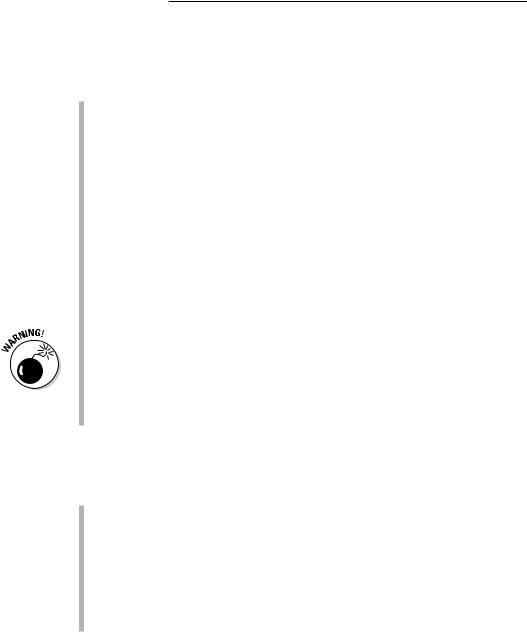
122 Part II: French in Action
Meat and poultry
The French menu may contain any — or all — of these varieties of les viandes (ley vyahNd) (meats) and volaille (voh-lahy) (poultry):
le boeuf (luh buhf) (beef). You can order your steak saignant (sehnyahN) (rare), à point (ah pwaN) (medium), or bien cuit (byaN kwee) (well done).
le veau (luh voh) (veal). La côte de veau (lah koht duh voh) is a veal chop.
l’agneau (m) (lah-nyoh) (lamb). Selections often include la côte d’agneau (lah koht dah-nyoh) (lamb chop) or un gigot (uhN zhee-goh) (leg of lamb).
le porc (luh pohr) (pork). La côte de porc (lah koht duh pohr) (pork chop) and le jambon (luh zhahN-bohN) (ham) are popular items.
la volaille (lah voh-lahy) (poultry). Your poultry selections can include le poulet (luh pooh-leh) (chicken), la dinde (lah daNd) (turkey), and le canard (luh kah-nahr) (duck).
What a difference an accent can make! Le pâté (luh pah-tey) is a meat paste, usually made from pork meat and spices, which is eaten as an appetizer with bread. Of course, there is also the famous pâté de foie gras d’oie (pah-tey duh fwah grah dwah) (goose liver pâté), which is more expensive. On the other hand, les pâtes (ley paht) are the familiar pastas. So watch out for that accent when you order, or you may be surprised by what you receive!
Seafood
Following are a variety of les fruits de mer (ley frwee duh mehr) (seafood) selections that commonly appear on French menus:
les poissons (ley pwah-sohN) (fish), such as le saumon (luh soh-mohN) (salmon), le thon (luh tohN) (tuna), l’espadon (m) (leh-spah-dohN) (swordfish), and la truite (lah trweet) (trout)
les crevettes (ley kruh-veht) (shrimp)
les huitres (ley wee-truh) (oysters)
le homard (luh oh-mahr) (lobster)
les coquilles Saint-Jacques (ley koh-keey saN zhahk) (scallops)
Le riz (luh ree) (rice), les pâtes (ley paht) (pasta), or les pommes de terre
(ley pohhm duh tehr) (potatoes) are often served with all of the above.
www.ATIBOOK.ir

Chapter 8: Bon Appétit! Dining Out and Going to the Market 123
Vegetables
Your mother always said, “Eat your vegetables!” With the selection you find on French menus, doing so isn’t a problem at all:
les légumes (ley ley-gewm) (vegetables)
les pommes de terre (ley pohhm duh tehr) (potatoes)
les haricots verts (ley ah-ree-koh vehr) (green beans)
les petits pois (ley puh-tee pwah) (peas)
les épinards (ley-zey-pee-nahr) (spinach)
les asperges (ley-zah-spehrzh) (asparagus)
le chou (luh shooh) (cabbage)
le chou-fleur (luh shooh-fluhr) (cauliflower)
les choux de Bruxelles (ley shooh duh brewk-sehl) (Brussels sprouts)
les poireaux (ley pwah-roh) (leaks)
les champignons (ley shahN-pee-nyohN) (mushrooms)
Cheeses
France is known for its wonderfully delicious fromages (froh-mahzh) (cheeses), and most French people eat le fromage with every meal. France is said to have a different cheese for each day of the year. In fact, France has many sayings about the importance of cheese, such as this one: Un repas sans fromage est comme une journée sans soleil (uhN ruh-pah sahN frohmahzh eh kohhm ewn zhoohr-ney sahN soh-lehy) (A meal without cheese is like a day without sun).
Cheeses you commonly see on a French menu may include le chèvre (luh shehv-ruh) (goat cheese), le camembert (luh kah-mahN-behr) (Camembert), and le brie (luh bree) (brie).
Desserts
Here are les desserts (ley deh-sehr) (desserts) you often see on French menus.
la glace (lah glahs) (ice cream)
la crème (lah krehm) (pudding)
la crème brulée (lah krehm brew-ley) (crème brulée)
le gâteau au chocolat (luh gah-toh oh shoh-koh-lah) (chocolate cake)
la tarte aux pommes (lah tahr-toh-pohhm) (apple tart)
www.ATIBOOK.ir
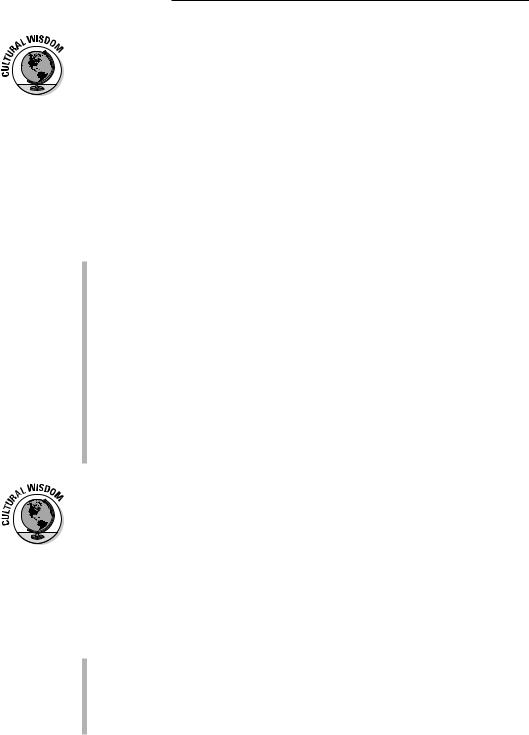
124 Part II: French in Action
The French eat ice cream and apple pie, but they don’t eat them together, which is funny, considering that the phrase à la mode (ah lah mohhd) (in fashion), which is often used in the U.S. to indicate pie with a scoop of ice cream, is a French phrase! French apple pies are also very different from their American counterpart. They are very thin and do not have a top crust. They look more like what Americans would call a tart.
Beverages
You surely want to compliment your delicious meal with a drink. Of course, the drink of choice in France is le vin (luh vaN) (wine). If you are in une brasserie (ewn brah-sree) (a pub), you may even want to try une bière à la pression (ewn byehr ah lah preh-syohN) (a draught beer). Of course, not all drinks have to be alcoholic. Here is a list of possible drinks that you can order at the local café or at any restaurant:
le jus d’orange (luh zhew doh-rahNzh) (orange juice)
le jus de pomme (luh zhew duh pohhm) (apple juice)
le jus de fruit (luh zhew duh frwee) (fruit juice)
le lait (luh leh) (milk)
l’eau minérale/gazeuse (loh mee-ney-rahl/gah-zuhz) (mineral, sparkling water)
la boisson gazeuse (lah bwah-sohN gah-zuhz) (soda)
le thé (luh tey) (tea)
le café (luh kah-fey) (coffee)
le chocolat chaud (luh shoh-koh-lah shoh) (hot chocolate)
Un apéritif (uhN-nah-pey-ree-teef) (an aperitif) is not just any drink, but more specifically a drink before the meal. Its purpose is to open the meal and the appetite. As an apéritif, the French like fairly mild alcoholic drinks like kir (keer), which consists of white wine or champagne with crème de cassis (krehm duh kah-sees) (blackcurrant liqueur); sweet wines like sherry or port, and so on; and they drink regular wine during the meal. Un digestif (uhN dee-zheh-steef) is an after-dinner drink, usually cognac or brandy, which, as the name indicates, is supposed to aid digestion. In general, un apéritif and un digestif are reserved for special occasions like family gatherings or dinner parties.
When you want to order specific quantities of a beverage, use these phrases:
un verre de. . . (uhN vehr duh. . . ) (a glass of. . .)
une bouteille de. . . (ewn booh-tehy duh . . .) (a bottle of. . .)
une carafe de . . . (ewn kah-rahf duh . . .) (a carafe of . . .)
une tasse de (ewn tahs duh . . .) (a cup of . . .)
www.ATIBOOK.ir
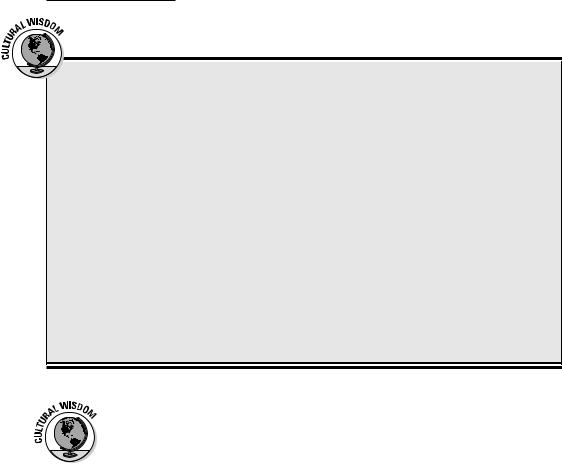
Chapter 8: Bon Appétit! Dining Out and Going to the Market 125
Coffee break
When you order coffee from a café or a restaurant in France, you get un express (uhN- nehk-sprehs) (an espresso) in a small cup. Only at breakfast do you get a medium-size pot of coffee with hot milk on the side, un café au lait
(uhN kah-fey oh leh). At home, the French drink café au lait in a large bowl in the morning rather than in a cup. If you want milk in your coffee at any other time of the day, you have to order un café crème (uhN kah-fey krehm) (coffee with milk). Of course, you can also order one of the following:
un double express (uhN dooh-blehk-sprehs) (a double espresso)
un grand crème (uhN grahN krehm) (a large coffee with milk)
Note: Large doesn’t mean large in the American sense, but more exactly double, which is the equivalent of two small espresso cups.
un déca/un décaféiné (uhN dey-kah/uhN dey-kaf-fey-ee-ney) (a decaf coffee)
If you’re really desperate for those gallons of weak coffee, many large hotels in Paris do offer un café américain (uhN kah-fey ah-mey-ree- kaN) (American coffee). You can also ask anywhere for de l’eau chaude (duh loh shohd) (hot water) and carry your instant coffee powder with you.
People seldom order wine by the glass in France. More often they order wine as un quart (uhN kahr) (a quarter of a liter), une demi-bouteille (ewn duh- mee-booh-tehy) (a half a bottle), or une bouteille (ewn booh-tehy) (a bottle). They order the house wine in une carafe (ewn kah-rahf) (a carafe) or un pichet (uhN pee-sheh) (a jug). In addition, you usually don’t have water on the table unless you say une carafe d’eau, s’il vous plaît (ewn kah-rahf doh, seel vooh pleh) (a pitcher of water, please).
Placing your order
You may want to ask the waiter a few questions about the dishes on the menu. Actually, the more sophisticated the restaurant, the less likely you are to understand its menu! The art of giving unusual names to dishes is almost as elaborate as the art of actually preparing them. And don’t think that you’re the only one who doesn’t understand. The average French restaurant-goer doesn’t either. Your best bet is to ask the waiter. You can also ask for the waiter’s recommendation by saying Qu’est-ce que vous recommandez/ suggérez? (kehs-kuh vooh ruh-kohh-mahN-dey/sewg-zhey-rey?) (What do
you recommend/suggest?)
www.ATIBOOK.ir
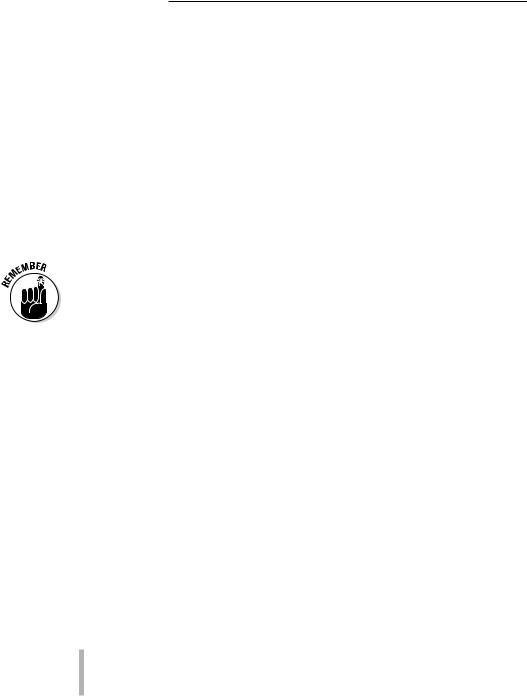
126 Part II: French in Action
When it’s time to order, the waiter will ask you these kinds of questions:
Qu’est-ce que vous voulez boire? (kehs-kuh vooh vooh-ley bwahr?) (What do you want to drink?). Or you may hear Qu’est-ce que vous voulez comme boisson? (kehs-kuh vooh vooh-ley kohhm bwah-sohN?), which more literally translates What do you want as a drink?
Avez-vous choisi? (ah-vey-vooh shwah-zee?) (Have you decided?)
Qu’est-ce que vous voulez prendre? (kehs-kuh vooh vooh-ley prahNdruh?) (What do you want to have [to eat/to drink]?)
Que prenez-vous comme plat principal? (kuh pruh-ney-vooh kohhm plah praN-see-pahl?) or Qu’est-ce que vous prenez comme plat principal? (kehs-kuh vooh pruh-ney kohhm plah praN-see-pahl?), both of which mean What will you have as a main course?
The phrase consisting of comme (kohhm) (as) followed by a noun is very commonly used in French, not only for food and drink items, but also each time you are asked to express a preference. For example, you may ask a friend
Qu’est-ce que vous aimez comme films? (kehs-kuh vooh-zehm-ey kohhm feelm?) (What kind of movies do you like?)
If you want to ask the waiter what kinds of selections are available, you use the question Qu’est-ce que vous avez comme. . . ? (kehs-kuh vooh-zah-vey kohhm . . . ?) (What do you have as. . .?). Take a look at these examples:
Qu’est-ce que vous avez comme boisson? (kehs-kuh vooh-zah-vey kohhm bwah-sohN?) (What do you have as a drink?). Alternatively, you can say Qu’est-ce qu’il y a comme boisson? (kehs-keel ee ah kohhm bwah-sohN?) (What is there as a drink?)
Qu’est-ce que vous avez comme vin? (kehs-kuh vooh-zah-vey kohhm vaN?) (Literally: What do you have as wine? or What kind of wine do you have?)
Qu’est-ce que vous avez comme entrée? (kehs-kuh vooh-zah-vey kohhm ahN-trey?) (What do you have as an appetizer?)
Qu’est-ce que vous avez comme fromage? (kehs-kuh vooh-zah-vey kohhm froh-mahzh?) (What do you have as cheese?)
When you’re all set and ready to order, you need to have these phrases handy:
Comme entrée, je prends. . . . (kohhm-ahN-trey, zhuh prahN. . . .) (For the first course [appetizer], I’ll have. . . .)
Je voudrais . . . . (zhuh vooh-dreh. . . .) (I would like. . . . )
www.ATIBOOK.ir

Chapter 8: Bon Appétit! Dining Out and Going to the Market 127
Pour moi. . . . (poohr mwah. . . .) (Literally: For me. . . .)
Et ensuite. . . . (ey ahN-sweet. . . .) (And then. . . .)
Et comme boisson. . . . (ey kohhm bwah-sohN. . . .) (And to drink. . . .)
Et comme dessert. . . . (ey kohhm deh-sehr. . . .) (And for dessert. . . .)
You no longer address the waiter as garçon (gahr-sohN), which is considered condescending because it means boy. Use monsieur (muh-syuh) (sir), instead. In case your server is une serveuse (ewn sehr-vuhz) (a waitress), you say madame (mah-dahm) (ma’am) or, if she is very young, mademoiselle (mahd- mwah-zehl) (miss).
Talkin’ the Talk
Julie, a young woman from Québec, and her friend Mike, visiting from the United States, have spent a long morning sightseeing in le vieux Montréal (luh vyuh mohN-rey-ahl) (the old Montreal).
They’re getting hungry, and the street is lined with restaurants.
Julie: Je meurs de faim, pas toi? zhuh muhr duh faN, pah twah?
I’m starving, aren’t you?
Mike: Moi aussi! Tu veux un sandwich?
mwah oh-see! tew vuh uhN sahN-dweesh?
Me too! Do you want a sandwich?
Julie: Oh non, il y a un tas de bons petits restaurants pas chers ici. Et puis je suis fatiguée.
oh nohN, eel ee ah uhN tah duh bohN puh-tee rehs- toh-rahN pah shehr ee-see. ey pwee zhuh swee fah-tee-gey.
Oh no, there are plenty of inexpensive little restaurants here. And I am tired.
Mike: Bon, d’accord. Alors, on mange dehors!
bohN, dah-kohr. ah-lohr, ohN mahNzh duh-ohr!
Well, okay. Let’s eat outside then!
After looking at a few places, they settle on a little bistro with a lovely terrace. They sit down and le serveur (luh sehr-vuhr) (the waiter) brings them the menu.
www.ATIBOOK.ir

128 Part II: French in Action
Le serveur: Vous voulez boire quelque chose? vooh vooh-ley bwahr kehl-kuh shohz?
Would you like something to drink?
Julie: Un verre de vin blanc, s’il vous plaît. uhN vehr duh vaN blahN, seel vooh pleh.
A glass of white wine, please.
Mike: Et pour moi, une bière.
ey poohr mwah, ewn byehr.
And for me, a beer.
A few minutes later, the waiter comes back with the drinks.
Le serveur: |
Voilà vos boissons. Vous avez choisi? |
|
vwah-lah voh bwah-sohN. vooh-zah-vey shwah-zee? |
|
Here are your drinks. Have you decided? |
Julie: |
Oui, je voudrais le poulet avec des pommes de terre |
|
et une salade verte. |
|
wee, zhuh vooh-dreh luh pooh-leh ah-vehk dey |
|
pohhm duh tehr ey ewn sah-lahd vehrt. |
|
Yes, I would like the chicken with potatoes and a |
|
green salad. |
Mike: |
Moi, je prends le steak-frites. |
|
mwah, zhuh prahN luh stehk-freet. |
|
Me, I’ll have the steak with fries. |
Le serveur: |
Et comme boisson, la même chose? |
|
ey kohhm bwah-sohN, lah mehm shohz? |
|
Would you like the same thing to drink? |
Mike: |
Oui, merci. |
|
wee, mehr-see. |
|
Yes, thank you. |
|
|
www.ATIBOOK.ir
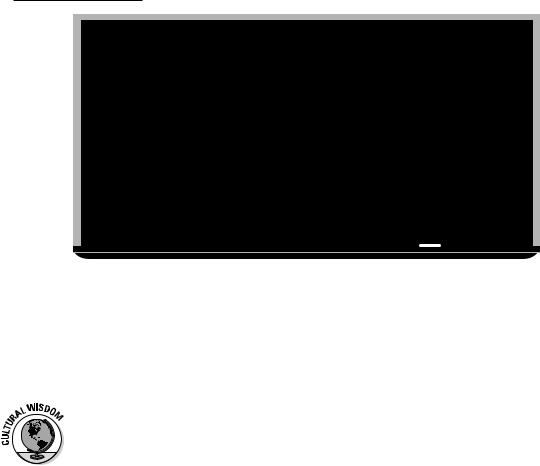
Chapter 8: Bon Appétit! Dining Out and Going to the Market 129
Words to Know
moi aussi |
mwah oh-see |
me too |
un tas de |
uhN tah duh |
lot’s of, plenty of |
cher/pas cher |
shehr/pah shehr |
expensive/ |
|
|
inexpensive |
dehors |
duh-ohr |
outside |
Avez-vous |
Ah-vey vooh |
Have you decided |
choisi? |
shwah-zee? |
(chosen)? |
la même chose |
lah mehm shohz |
the same thing |
Paying the bill
After you finish your lovely meal, it’s time to pay the bill. But don’t expect a waiter in France to bring you the check before you ask for it. (That’s considered pushy and impolite.) To get your check, call the waiter and say L’addition, s’il vous plaît (lah-dee-syohN, seel vooh pleh) (Check, please).
In France, the tax and a 15 percent tip are included in the price list: le pourboire est compris (luh poohr-bwahr eh kohN-pree) or le service est compris
(luh sehr-vees eh kohN-pree) (the tip is included). What you see is what you get. Of course, you may tip extra if you so desire, especially in a very good restaurant, but in cafés and ordinary restaurants, you don’t have to. In Canada,
a tax is added to your check, and the waiter expects to be tipped in addition (about 15 percent).
Le pourboire (luh poohr-bwahr) (the tip) is a funny word in French. It literally means in order to drink. This very old word dates back to the 17th century when it was customary to give a tip so the recipient could go and buy himself a drink (alcoholic supposedly). The name has remained, but its function has changed; today many waiters and theater ushers are paid only with tips.
www.ATIBOOK.ir
